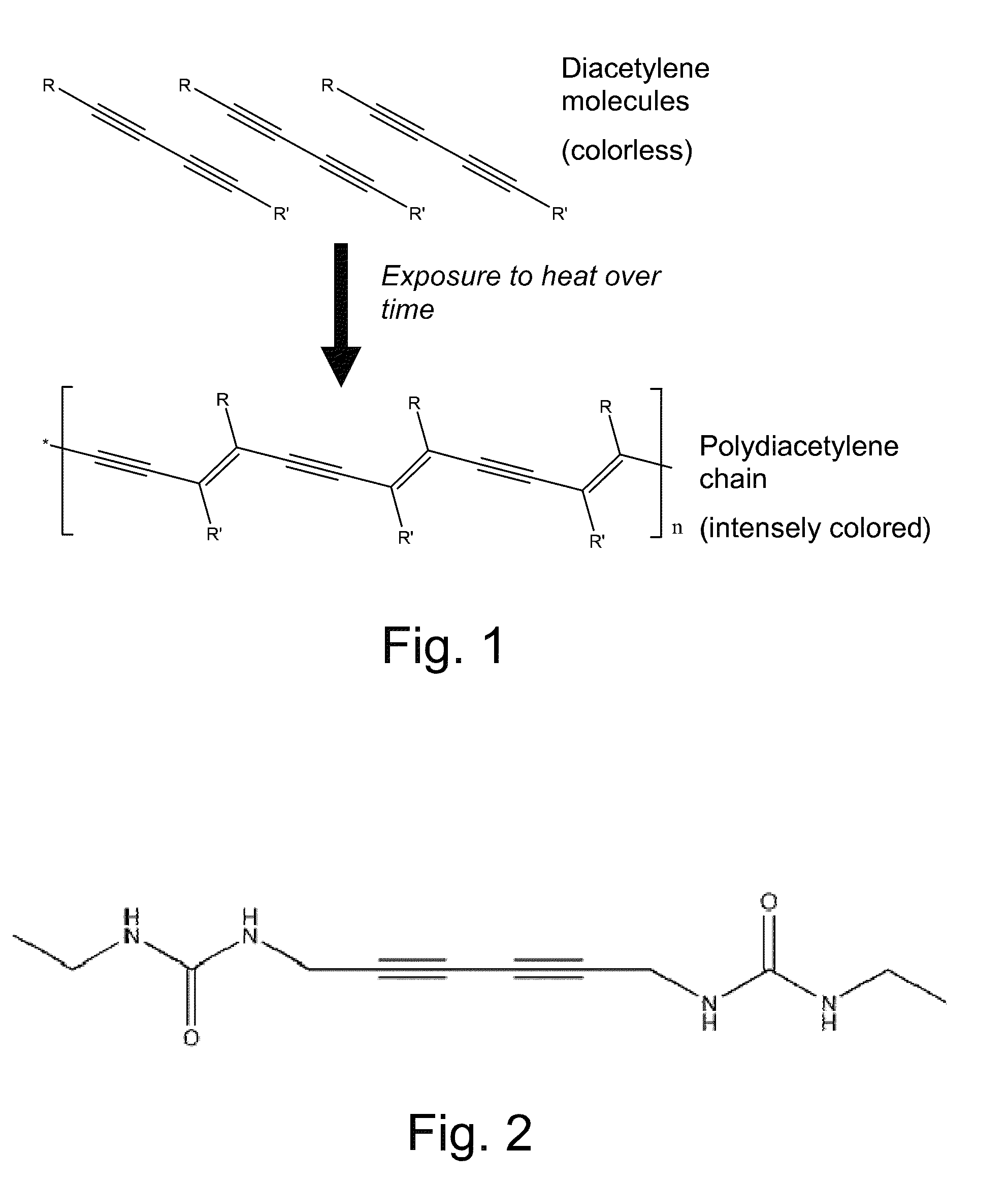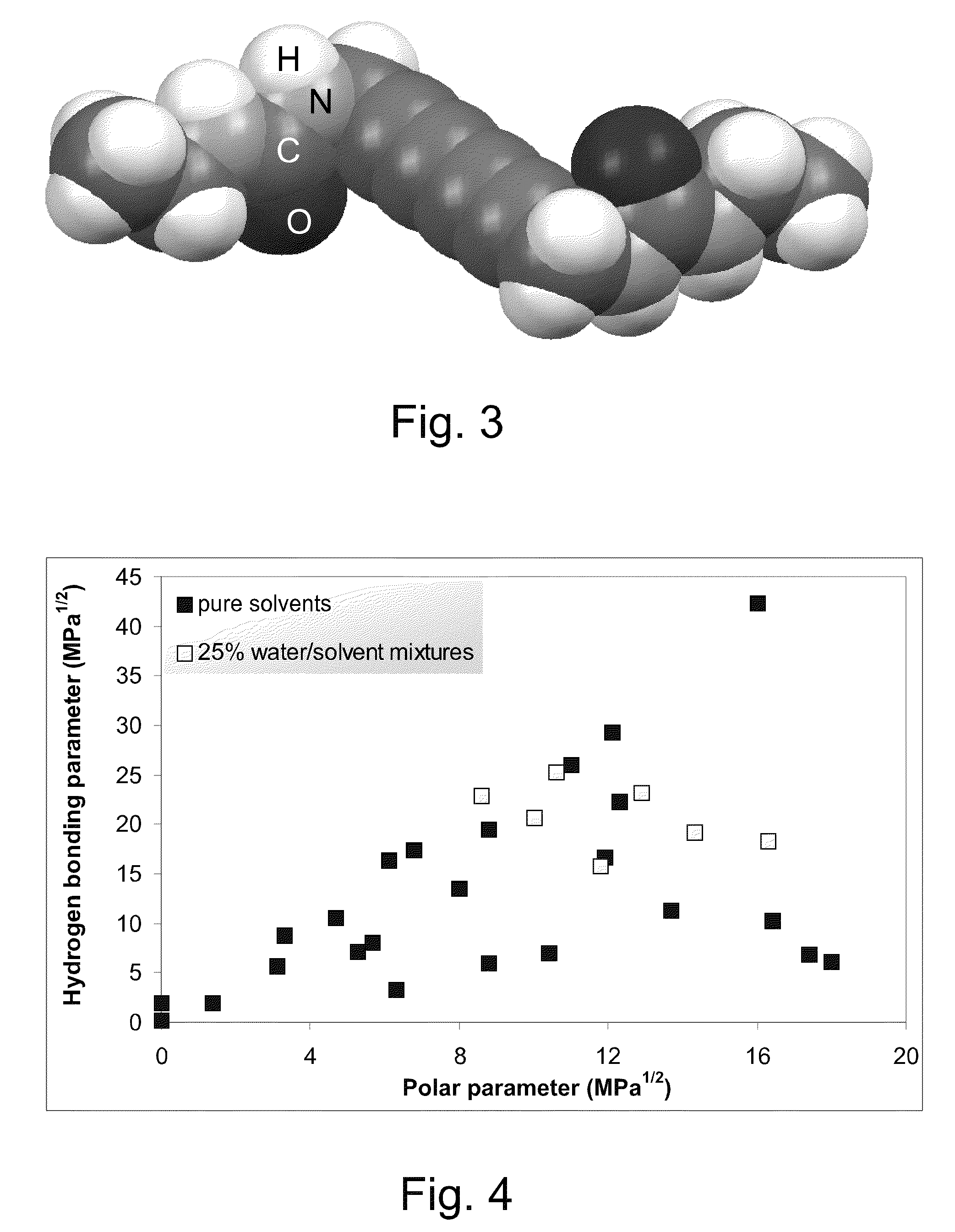Crystallized diacetylenic indicator compounds and methods of preparing the compounds
a technology of diacetylenic indicator and compound, which is applied in the field of crystallized diacetylenic indicator compound and method of preparation, can solve the problems of limiting the choice of response parameter of indicator formulator, unable to provide specific information regarding the solubilities of diacetylenic compound in such other solvents, and unable to use reversible indicators for these purposes. , to achieve the effect of expanding the scope of potential commercial applications of diacetyl
- Summary
- Abstract
- Description
- Claims
- Application Information
AI Technical Summary
Benefits of technology
Problems solved by technology
Method used
Image
Examples
example 1
Solubility Tests and Definition of a Solubility Region
[0126]This example illustrates solvent mapping, testing and solubility region definition for a diacetylenic monomer for which new solvents and solubility information are desired, namely 2,4-hexadiyn-1,6-bis(ethylurea) and for which reliable solubility parameter information is not available. In this example, solubility points are mapped for each of a number of representative samples of a wide range of solvents of different chemical types and physicochemical characteristics, according to their solubility parameters. The solubility points of the representative solvents (filled squares) are mapped on a plot of hydrogen bonding (δH), on the Y-axis, versus polar parameters (δP), on the X-axis, generating a map such as that shown in FIG. 4. Also shown in FIG. 4 are solubility points for solvent systems comprising 25 percent by weight water / solvent mixtures (unfilled squares). These mixtures are suggested as potentially useful solvent sy...
example 2
Further Solubility Tests
[0134]The Example 1 solubility tests are then repeated for different solute concentrations, in this case 4 percent, 7 percent, and 10 percent by weight of 2,4-hexadiyn-1,6-bis(ethylurea) in each of the solvents demonstrating at least 1 percent solubility in the previous test as well as the water / solvent mixtures. A 90° C. water bath is employed to maintain the solvent or solution temperature and results obtainable are tabulated in Table 2 below, solubility parameter information again being included to facilitate understanding of the data for acetone and water, for reference.
[0135]
TABLE 2Solubility Trial Results at Various SolubilitiesPolarHydrogenSolventparameterparameterBoil TempIs KE soluble atname(MPa1 / 2)(MPa1 / 2)(° C.)1%?4%?7%?10%?Acetone10.47.056NoNoNoNo25% Water / Acetone11.815.861YesYesNoNoMethanol12.322.365YesYesNoNoEthanol8.819.478YesNoNoNo25% Water / IPA8.622.981YesNoNoNo2-Propanol (IPA)6.116.482YesNoNoNo25% Water / Ethanol10.625.283YesYesNoNo1-Propanol6.8...
example 2a
Solubility of 5,7-dodecadiyn-1,12-bis-n-octadecyl Urethane (“4DOD”)
[0170]To serve as indicator agent, a thermally insensitive polymerizable diacetylenic monomer, namely 5,7-dodecadiyn-1,12 diol bis(n-octadecyl urethane), “4DOD” hereinafter, is synthesized in sufficient quantity for preparation of a master batch of ink, by the method described in Yee U.S. Pat. No. 4,215,208 at column 17, lines 47-65 and is stored in a freezer. A small quantity of 4DOD is taken from frozen storage and is tested at room temperature for solubility in various solvent systems employing the following procedure.
[0171]100 g of deionized water is weighed into a 200 mL glass beaker. 4DOD powder is added to the glass beaker until the solution is saturated allowing excess 4DOD to remain present as undissolved solid. 75 g of deionized water is weighed into another 200 mL glass beaker, and 25 g acetone is added. 4DOD is then added to the water-acetone solvent system in the glass beaker until the solution is satura...
PUM
| Property | Measurement | Unit |
|---|---|---|
| γ | aaaaa | aaaaa |
| γ | aaaaa | aaaaa |
| γ | aaaaa | aaaaa |
Abstract
Description
Claims
Application Information
 Login to View More
Login to View More - R&D
- Intellectual Property
- Life Sciences
- Materials
- Tech Scout
- Unparalleled Data Quality
- Higher Quality Content
- 60% Fewer Hallucinations
Browse by: Latest US Patents, China's latest patents, Technical Efficacy Thesaurus, Application Domain, Technology Topic, Popular Technical Reports.
© 2025 PatSnap. All rights reserved.Legal|Privacy policy|Modern Slavery Act Transparency Statement|Sitemap|About US| Contact US: help@patsnap.com



